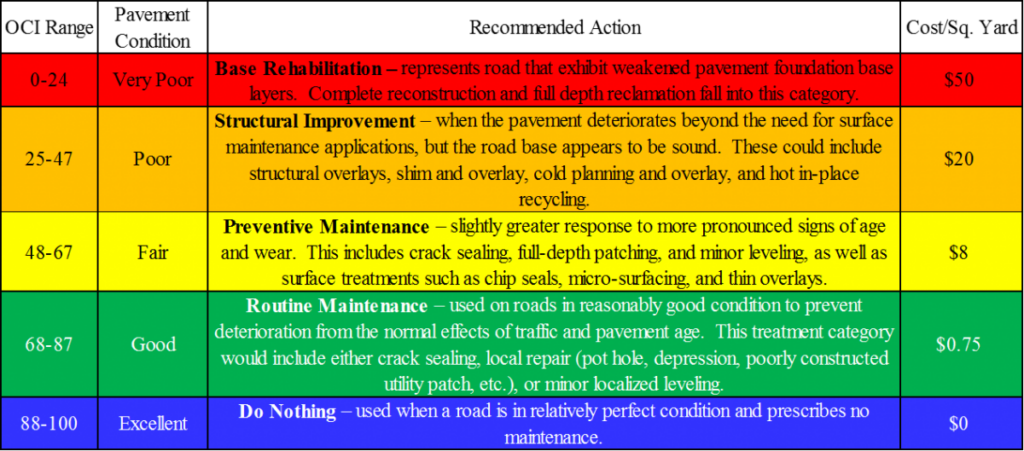The Central Massachusetts Regional Planning Commission (CMRPC) staff has developed an Asset Management System (AMS) to assess conditions, funding needs, and recommend repair strategies for the region’s road system. The asset management process is conducted with the intent to keep the road system in the best possible condition with the most efficient use of available funds.
The key to having an efficient and effective asset management system lies in the project prioritization process. A list of priority areas can be used to inform decision-makers choosing projects for local asset planning and for larger efforts such as the Transportation Improvement Program (TIP) and Long-Range Transportation Plan (LRTP). Due to the reality of limited financial resources, it is necessary to prioritize repairs based on affordability and impact. Deciding which assets to improve and by what technique in a fiscally responsible manner is the goal of asset management.
The assets monitored as part of this process include road pavement, sidewalks, curb ramps, traffic signals, bridges, and culverts. To inform the AMS, CMRPC staff assess the condition of the included assets in the region using data from field surveys, statewide programs, and other available data sets as needed.
What is an Asset Management System?
An Asset Management System (AMS) is a planning tool utilized to collect and monitor the current information on an asset’s location, type, current & future condition as well as evaluate and prioritize asset maintenance and rehabilitation. The goal of the AMS is to provide decision-makers with the necessary information for understanding the required funding and strategies to maintain the condition of the region’s road network. When properly implemented, the AMS will provide greater value and overall satisfaction for end-users through improvements in program effectiveness and system performance. To be successful, performance metrics must be used as the guide for decision making and informed by economic and engineering constraints.
Why use an Asset Management System?
Road networks are a multimillion-dollar taxpayer investment that directly impacts the community’s economic well-being and quality of life. Every dollar invested constructing a new asset to improve mobility or reduce delay, adds a future expense in maintaining, operating, preserving, and eventually reconstructing that asset. Preservation strategies can extend the life of an asset and postpone reconstruction at a cost-benefit of more than 10 to 1 (One dollar spent today can save ten dollars in the future). The use of a AMS to make resource allocation and programming decisions will provide greater value to the system and overall satisfaction for all users. Since budgets are often limited, an asset owner must answer some important questions when setting up a AMS and making programmatic decisions:
- What assets are part of the AMS?
- What is the current condition of the assets?
- Which assets should be repaired first?
- What techniques should be used for best results?
- What are the projected long-term consequences if repairs are delayed or deferred?
How does an Asset Management System work?
An AMS helps select the type of repair that is most cost-effective based upon the current condition of each asset. The generic deterioration curve illustrates how an assets overall condition changes as it ages. When first installed or built, the asset is in good condition. Typically, the condition slowly deteriorates in the first years of service from good to the lower end of the good range. The deterioration rate accelerates as the asset moves through the middle to the end of its service life, eventually requiring replacement.

The portion of the road network that the CMRPC AMS focuses on are federal-aid eligible roads and the assets located along them. A combination of functional classification and urban/rural designation determines if a roadway qualifies as a federal-aid eligible road. Eligibility includes all interstates, urban/rural arterials, urban collectors, and rural major collectors while rural minor collectors have a capped federal-aid funding eligibility. The CMRPC AMS helps to inform the project initiation and selection process. For the purposes of this report assets (sidewalks, ramps, signals, culverts and bridges) located along federal-aid eligible roads (pavement) are also considered to be federal-aid eligible. The AMS uses the data provided to select general groups of repairs referred to as “repair strategies” which contain several specific repair-alternatives that can be selected from. The term “repair strategy” is used to emphasize that this is a step in an overall approach to selecting maintenance and repair actions. Below is an example of a table showing the repair strategies used for pavement assets.

Resources
For more information on all of the assets included in the CMRPC AMS please view the 2020 AMS Report and the CMRPC Asset Management Viewer.

